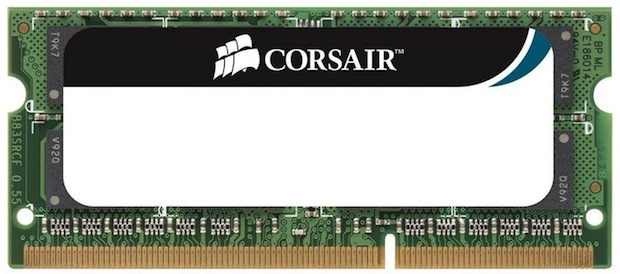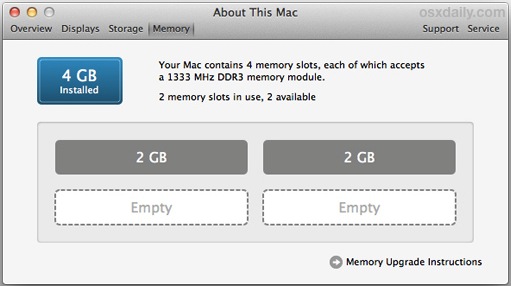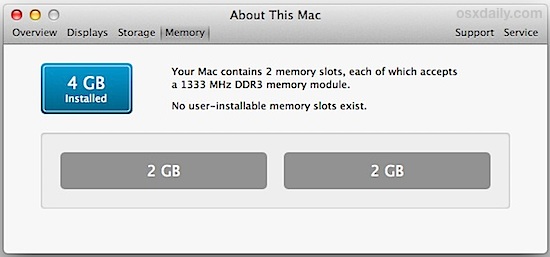Find What Type of RAM a Mac Uses & the Maximum Supported Memory
Different Mac models use different types of RAM, and each also supports a different maximum level of RAM. Unless you spend a lot of time upgrading and repairing Macs yourself, you probably don’t know these exact details off the top of your head, and that’s just fine because the information can be retrieved directly from the Mac in most cases. This is vital information to know if you have determined a memory upgrade is in order, so we’ll cover several different ways to find out what RAM type and speed a given Mac uses, what the maximum amount of supported RAM is, and if RAM slots are available.

1: Check the Mac for RAM Type & Memory Slot Details
The quickest way to find out RAM details of a Mac is to check About This Mac, which will identify the memory module type and speed, how many RAM slots there are on the Mac, and which slots are in use.
- Pull down the Apple menu and go to “About this Mac”
- Click the “More Info…” button to summon System Information
- Look under the “Memory” tab for information about your Mac RAM, including maximum capacity, used memory slots, and which type of RAM the Mac accepts
All Macs will show the maximum RAM, what size RAM modules are installed, if there are open memory slots, and the RAM speed used. Here’s an example showing a Mac with available slots:

If the Mac is not upgradeable because RAM is either inaccessible to users or soldered onto the board, which is commonly the case for MacBook Air and Retina MacBook Pro models, then you will still find the RAM details, but there will be no available slots shown like so:

Finding the RAM Type & Speed
If you have determined slots are available and the Mac can support more RAM, the most important information to know when ordering or looking for upgrade modules is the RAM module type and speed, which is always shown at the top of the “Memory” screen and labeled something like “Your Mac contains 4 memory slots, each of which accepts a 1333 MHz DDR3 memory module.” It’s the “1333 MHz DDR3” (or whatever it says) part that is most important to know:

If for some reason you can’t boot the Mac, or if it’s older and doesn’t have memory details in System Information, you can use other options to find the RAM type, speed, and maximum capacity as well.
2: Use MacTracker
MacTracker is an excellent free app that provides tons of hardware details on just about every Apple product ever released, including Macs. Conveniently, the app runs on both iOS and OS X, so download whichever version you prefer (again, it’s free):
- Grab the Mac version of MacTracker from the developer
- Grab the free iOS version for iPhone, iPad, and iPod touch
Though MacTracker contains an abundance of information, we’re using it specifically for Memory information, so locate your Mac through the list or search, then choose the Memory tab to see details about the Macs RAM capacity, type, and if it’s user serviceable (i.e.: upgradable) or not.
![]()
The iOS version is an excellent companion app for more technical Mac users who like to perform hardware upgrades on their own, but both desktop and mobile versions contain the same treasure trove of information about hardware. This is one of those apps that is so freakishly useful that every technically-minded Mac or Apple hardware owner should have it installed.
3: Check Apple Web Support
Can’t download MacTracker, and can’t find any information in About This Mac? You can also turn to Apple’s web support, which has a huge knowledge base of technical details on every Mac model:
- Go to Apple Support knowledge base for Macs, and select your general Mac model from the list
- Choose “Tech Specs” and locate the precise model and model year
- Look for “Memory” to find the RAM type and maximum supported RAM amount
Apple’s web support is easy enough to use, and because it’s available on the web it’s accessible from just about any device. So if your MacBook Pro has bad memory chips and won’t power on, and you only have an Android phone or a Windows PC available to you, you can still use Apple’s support site to get the important details.
4: Use RAM Resellers
Finally, you can always get the exact RAM type, capacity, and maximum from the myriad of memory sellers out there. Crucial has the Mac Memory Advisor tool which is extremely easy to use, and you can always just search Amazon for Mac RAM with a model name to find the RAM upgrade kits available to that specific hardware, the largest kit of which is the maximum supported amount.
If you are upgrading RAM on your own, don’t forget to run a memory test on the new modules to be sure that everything is in full working order. Though RAM is checked at the factory before shipping out, every once in a while a bad chip does get through the quality assurance process and ends up in the hands of a user. Frustratingly, sometimes that bad memory will actually work just fine… to an extent at least… and only cause weird issues and crashes. But that’s exactly why the aforementioned RAM test is important, it can help you weed out such a problem before it causes any annoyances.


How can you check the memory timing of installed DIMMs? I have several DIMMs I want to install in an older Mac Pro cheese grater but the timing is not printed on them. Is there an app tat can tell you the timing of a DIMM?